Crassula foveata
Crassula foveata Van Jaarsv.
Family: Crassulaceae
Common names: pitted cliff-crassula (Eng.), Mzimvubu-kransplakkie (Afr.)
Introduction
Crassula foveata is a solitary to mat-forming, freely branched succulent becoming a cliff-hugger. The leaves are in a loose rosette, yellowish green becoming reddish during dry periods, the leaf surface is distinctly marked with rounded, reddish pits. The small star-shaped, white to light pink flowers are in short, rounded to flat-topped inflorescences, in autumn. Plants grow wild on cliffs in dry river valleys of the Eastern Cape. Easily grown as a potted plant.
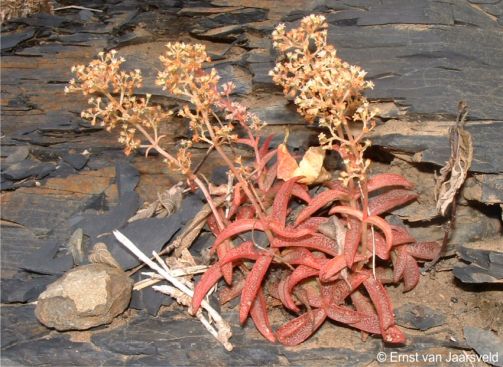
Fig. 1. A group of Crassula foveata plants in flower in the natural habitat on Beaufort Shale cliffs along the Mzimvubu River, Eastern Cape, South Africa.
Description
Description
The plants grow solitary or proliferating from base, forming small, dense mats to clusters up to 100 mm in diameter. Roots fibrous. Branches short, herbaceous, 20–40 mm long, terete, sparsely strigose, hairless (glabrous) lower down, 1–1.5 mm in diameter, green, becoming reddish when exposed to drought. The leaves are arranged in a loose rosette, sessile, crowded, compact, in opposite pairs (decussately arranged), sometimes sickle-shaped (falcate) and spreading, slightly recurved, becoming smaller towards the ends of the stems, linear-lanceolate to triangular-lanceolate, 12–24 × 3–7 mm, apex acute, apiculate. The leaf surface is smooth (glabrous), green becoming reddish, distinctly pitted (foveate, with shallow leaf depressions), the pits, caused by sunken hydathodes, are rounded, reddish to purplish depressions, 0.3–0.5 mm in diameter. The abaxial leaf surface is rounded, foveate, the adaxial surface canaliculate. The leaf margin is rounded, thickened, sparsely beset with recurved translucent cilia. Inflorescence a conspicuous rounded to flat-topped thyrse up to 50 mm high and 50 mm in diameter, bearing 1–several dichasia; peduncle with translucent recurved hairs and a gradual transition of leaves to bracts, reddish; bracts ascending-spreading, distal bracts boat-shaped (cymbiform), sparsely pitted, margin entire to sparsely ciliate. The flowers are diurnal, sweetly scented, white to light pink, buds 3 mm long, open flowers 4 mm in diameter. Calyx lobes triangular with stout hair at apex, 1.5 × 0.8 mm. Corolla tubular, lobes spreading, oblong-ovate to ovate-lanceolate, up to 2 mm long, white to pink, apices apiculate. Stamens 1.5 mm long; anthers yellowish, 0.1 mm long. Squamae transversely oblong, 0.4 × 0.1 mm, yellowish orange. Carpel and style 2 mm long. Flowering time is in early autumn (March–April).

Fig. 2. A Crassula foveata plant in flower in its natural habitat on Beaufort Shale cliffs of the Mzimvubu River. The flowers are strongly scented during the day.
Conservation Status
Status
Assessed as Rare by the Red List of South African Plants. Although Crassula foveata is widespread, it is a habitat specialist and not locally common, but it is well protected by its inaccessible cliff habitat and is not facing any severe threats.
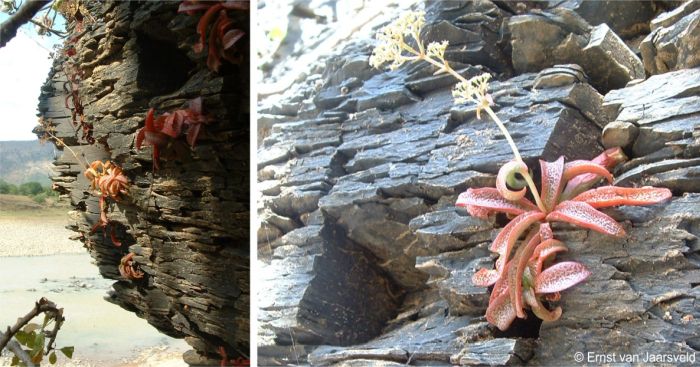
Fig. 3. Crassula foveata, growing on the dark, broken, Beaufort Shale cliffs of the Mzimvubu River.
Distribution and habitat
Distribution description
Crassula foveata is known from the dry river valleys of the Mbashe and Mzimvubu Rivers of the Eastern Cape. The plants grow on cliffs along these rivers, on all aspects but mainly on exposed northern and western aspects, at an altitude of 300–800 m. The geology consists mainly of sandstone, shale and mudstone (Adelaide Subgroup, Karoo Supergroup). Plants grow in crevices or among leaf litter in shallow soil on rocky ledges and often in the shade of cliff-dwelling shrubs or trees. Temperatures are high in summer and mild in winter. The average daily maximum temperature is about 24°C and the average daily minimum about 12°C. Rainfall occurs mainly in summer and ranges from 800–1000 mm per annum mainly in the form of thunder showers between October and May.

Fig. 4. The Mzimvubu River, habitat of Crassula foveata. Plants grow on Beaufort Shale cliffs.
The associated vegetation consists of Eastern Valley Bushveld of the Savanna Biome. Associated cliff-dwelling plants in its habitat at Colleywobbles along the Mbashe River include Mesembryanthemum cordifolium (= Aptenia cordifolia), Cotyledon orbiculata, Crassula cordata, C. lactea, C. perfoliata var. minor and C. perforata, Delosperma sp., Drimia anomala and Albuca bracteata (= Ornithogalum longibracteatum).
Along the Mzimvubu River plants were noticed growing on cliffs in association with Gasteria loedolffiae, Adromischus cristatus subsp. mzimvubuensis, Crassula perforata, Crassula cordata and Cynanchum viminale.
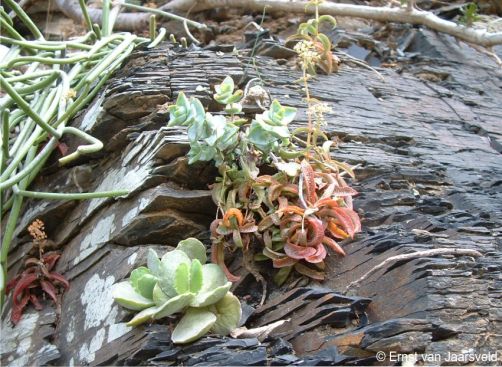
Fig. 5. Crassula foveata, sharing its natural habitat, the Beaufort Shale cliffs of the Mzimvubu River, with Adromischus cristatus subsp. mzimvubuensis, Crassula perforata and Cynanchum viminale.
Derivation of name and historical aspects
History
Crassula foveata was named by Braam van Wyk and the author in the Bothalia magazine in 2003. Crassula foveata belongs to section Rosulares created by the British succulent student Adrian Haworth to accommodate species with leaves in a basal rosettes and the leaves with obvolute vernation. Section Rosulares contains 25 species, which Haworth named in 1821, of which eight are cliff dwelling (cremnophilous). From other members belonging to Rosulares, Crassula foveata is immediately distinguished by its densely pitted leaves – hence the name foveata, which is Latin, meaning ‘having pits’.
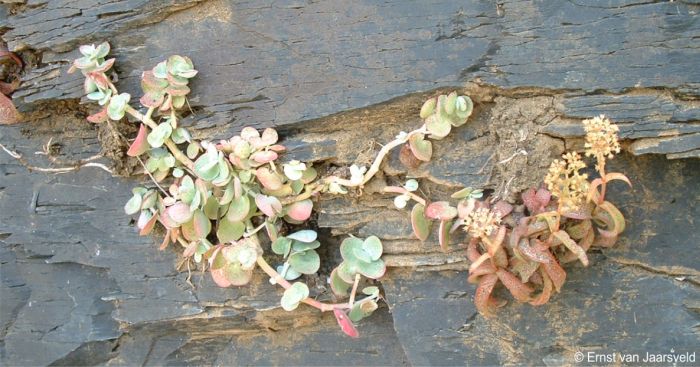
Fig. 6. Crassula foveata, sharing its Beaufort Shale cliff habitat with Crassula cordata.
Ecology
Ecology
The leaves of Crassula foveata are ascending-spreading, variable in shape, almost subulate to dorsiventrally compressed, compact, and decussately arranged, becoming reddish during dry periods. The rounded, narrow leaves, reduce the size and surface area of the leaf, and its compact nature, so typical of many cremnophytes, can be viewed as adaptations to the dry conditions on the cliff face. The leaf surface (epidermis) is green, becoming reddish-purple, and darker pitted during dry conditions resulting in a mottled appearance. The leaf margin is sparsely ciliate. The reddish colour, caused by the production of anthocyanins, during dry conditions, reduces penetration of excessive light, an adaptation resulting from the well-drained habitat.
The soft-leaved plant bodies without conspicuous armament suggests adaptation to the largely undisturbed cliff-face habitat and the absence of herbivores.
Flowering occurs during autumn, the strong scent suggesting a day-flying insect as the pollinating agent. The fruits (follicles) becomes dehiscent when ripe, with seeds spontaneously released and dispersed by wind. The seeds are released in autumn and winter at the onset of cooler conditions, maximising establishment. The seeds are minute, and ideal for establishment in crevices
Crassula foveata is prolific from the base, forming dense vegetative clusters. When an offshoot becomes detached, as a result of heavy wind or some other disturbance, it will root if it falls into a new crevice. This vegetative reproductive backup strategy ensures long-term survival.
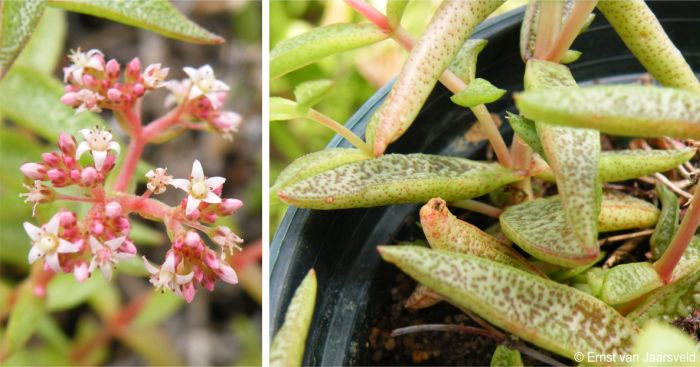
Fig. 7. A close-up of Crassula foveata flowers and the pitted leaves of a plant growing at Kirstenbosch National Botanical Garden, orginally collected from the Mzimvubu River, Eastern Cape.
Uses
Use
It is not known whether the plants are used medicinally. Crassula foveata is fairly easily grown and makes a beautiful pot plant.
Growing Crassula foveata
Grow
Best for bushveld gardens, grown in rockeries, on embankments or as a pot plant. Outside its native habitat, it is best grown under controlled conditions in a greenhouse. Easily cultivated, it prefers dappled shade. The soil should be sandy and well-drained. Add ample well-rotted compost as a mulch or feed with a liquid organic fertiliser. Water well, but allow plants to dry out for some time before watering again. The stored moisture in their leaves and stems allow succulents to survive when no soil moisture is present.
Propagate from division, cuttings or seed. Best propagated by division or offsets or from leaf cuttings taken during spring or autumn. Plant rosettes in a sandy soil. Leaves can be cut near the base and allowed to callus on a shady window sill. Best time is during spring and summer. Seed is fine and can be sown in a sandy mixture. Sow seeds in autumn and cover with a very thin layer of gravel. Keep moist. Remove seedlings as soon they are large enough to handle.
The roots sometimes can be affected by mealybug and treated accordingly.
References
- Christenhusz, M.J.M., Fay, M.F. & Chase, M.W. 2017. Plants of the World, an illustrated Encyclopedia of vascular plants. Kew Publishing, Royal Botanic Gardens, Kew.
- Eggli, U. (ed.) 2003. Illustrated handbook of succulent plants: Crassulaceae. Springer, Berlin.
- Mucina, L. & Rutherford, M.C. (eds) 2006. The vegetation of South Africa, Lesotho and Swaziland. Strelitzia 19. South African National Biodiversity Institute, Pretoria.
- Rowley, G. 2003. Crassula: a growers guide. Cactus & Co. Vista, California.
- Toelken, H.R. 1985. Crassulaceae. Flora of Southern Africa 14: 1–244.
- Van Jaarsveld, E.J. & Van Wyk, A.E. 2003. Hyacinthaceae and Crassulaceae: two new cremnophilous taxa from semi-arid regions in South Africa. Bothalia 33: 115–118.
- Van Jaarsveld, E.J. & Van Wyk, A.E. 2003. New cliff-dwelling Crassulaceae from the Eastern Cape: a new Cotyledon and two new Adromischus taxa from the Mbashe and Mzimvubu Rivers, South Africa. Aloe 40(2): 36–40.
- Van Jaarsveld, E.J., Styles, D.G.A. & MacDonald, G.J. 2008. Crassula smithii, a new cliff-dwelling species from Noodsberg, KwaZulu-Natal, South Africa. Aloe 45(4): 90–92.
- Von Staden, L. 2017. Crassula foveata Van Jaarsv. National Assessment: Red List of South African Plants. Online. https://redlist.sanbi.org/species.php?species=3835-942.
Credits
Ernst van Jaarsveld
Master Botanist
Kirstenbosch National Botanical Garden (Retired)
Babylonstoren Farm (Current)
Extraordinary senior lecturer and researcher,
Department of Biodiversity and Conservation, University of the Western Cape
April 2025
Plant Attributes:
Plant Type: Succulent
SA Distribution: Eastern Cape
Soil type: Sandy, Loam
Flowering season: Late Summer, Autumn
PH: Acid, Neutral
Flower colour: White
Aspect: Full Sun, Shade, Morning Sun (Semi Shade), Afternoon Sun (Semi Shade)
Gardening skill: Average
Special Features:
Horticultural zones
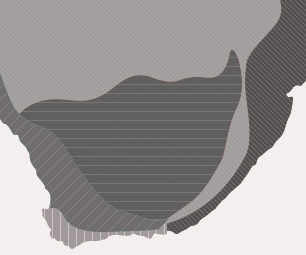







Rate this article
Article well written and informative
Rate this plant
Is this an interesting plant?
Login to add your Comment
Back to topNot registered yet? Click here to register.